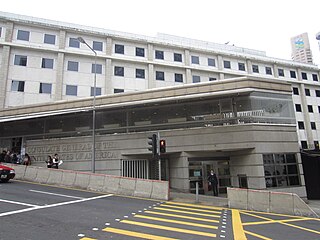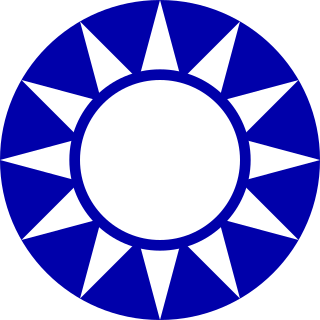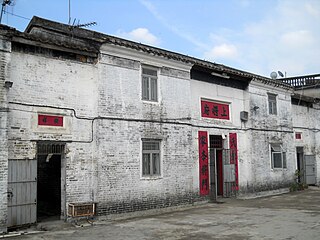Related Research Articles

Feng Yuxiang, courtesy name Huanzhang (焕章), was a Chinese warlord and a leader of the Republic of China from Chaohu, Anhui. He served as Vice Premier of the Republic of China from 1928 to 1930. He was also known as the "Christian General" for his zeal to convert his troops and the "Traitorous General" for his penchant to break with the establishment. In 1911 he was an officer in the ranks of Yuan Shikai's Beiyang Army but joined forces with revolutionaries against the Qing dynasty. He rose to high rank within Wu Peifu's Zhili warlord faction but launched the Beijing Coup in 1924 that knocked Zhili out of power and brought Sun Yat-sen to Beijing. He joined the Nationalist Party (KMT), supported the Northern Expedition and became blood brothers with Chiang Kai-shek, but resisted Chiang's consolidation of power in the Central Plains War and broke with him again in resisting Japanese incursions in 1933. He spent his later years supporting the Revolutionary Committee of the Kuomintang.

Sir Mark Aitchison Young was a British administrator who became the Governor of Hong Kong during the years immediately before and after the Japanese occupation of the territory.

Karl Friedrich August Gützlaff, anglicised as Charles Gutzlaff, was a German Lutheran missionary to the Far East, notable as one of the first Protestant missionaries in Bangkok, Thailand (1828) and in Korea (1832). He was also the first Lutheran missionary to China. He was a magistrate in Ningbo and Zhoushan and the second Chinese Secretary of the British administration in Hong Kong.

Sir Cecil Clementi was a British colonial administrator who served as Governor of Hong Kong from 1925 to 1930, and Governor and Commander-in-Chief of the Straits Settlements from 1930 to 1934.

Sir Francis Henry May was a British colonial administrator who served as Governor of Fiji from 1911 to 1912 and Governor of Hong Kong from 1912 to 1918.

HMS Tamar was the name for the British Royal Navy's base in Hong Kong from 1897 to 1997. It took its name from HMS Tamar, a ship that was used as the base until replaced by buildings ashore.

Zhang Fakui was a Chinese Nationalist general who fought against northern warlords, the Imperial Japanese Army and Chinese Communist forces in his military career. He served as commander-in-chief of the 8th Army Group and commander-in-chief of NRA ground force before retiring in Hong Kong in 1949.

The Canton Operation was part of a campaign by Japan during the Second Sino-Japanese War to blockade China to prevent it from communicating with the outside world and importing needed arms and materials. Control of Guangzhou (Canton) and the Pearl River Delta would provide a base to make the blockade of Guangdong province more effective by seizing southern China's major port and isolate the British port of British Hong Kong.

The Consulate General of the United States, Hong Kong and Macau, represents the United States in Hong Kong and Macau.
The Commander British Forces in Hong Kong (CBF) was a senior British Army officer who acted as Military Advisor to the Governor of Hong Kong and was in charge of the Hong Kong British Forces. The officeholder of this post concurrently assumed the office of the Lieutenant Governor of Hong Kong before the abolition of the position.

The Kuomintang Islamic insurgency was a continuation of the Chinese Civil War by Chinese Muslim Kuomintang Republic of China Army forces mainly in Northwest China, in the provinces of Gansu, Qinghai, Ningxia, and Xinjiang, and another insurgency in Yunnan.

The Last Tycoon is a 2012 Hong Kong period drama film directed by Wong Jing, starring Chow Yun-fat, Sammo Hung, Francis Ng and Huang Xiaoming. The film was released in mainland China on 22 December 2012, and in Hong Kong on 3 January 2013. The story is loosely inspired by the life of Du Yuesheng, a prominent mob boss in Shanghai in the 1920s and 1930s.
Thomas Henderson Whitehead was a Scottish banker in Hong Kong and member of the Executive Council and Legislative Council of Hong Kong.

Tianyi Film Company, also called Unique Film Productions, was one of the "big three" film production companies in pre-Second World War Republic of China. Founded in Shanghai in 1925 by the Shaw (Shao) brothers led by Runje Shaw, the company also established operations in Malaya and Hong Kong. Although the company's Shanghai studio was destroyed in 1937 during the Japanese invasion, its offshoot in Hong Kong, later called Shaw Brothers Studio, blossomed into a media empire under the leadership of the youngest brother, Sir Run Run Shaw.
Bernard Francis Meyer, M.M. was an American Catholic missionary. As a member of the Catholic Foreign Mission Society of America (Maryknoll), he was assigned to missions in China. He served as the Prefect Apostolic of Wuzhou from 1934 to 1939.

Weihaiwei or Wei-hai-wei on the northeastern coast of China, was a leased territory of the United Kingdom from 1898 until 1930. The capital was Port Edward, which lay in what is now the centre of Huancui District in the city of Weihai in the province of Shandong. The leased territory covered 288 square miles (750 km2) and included the walled city of Weihaiwei, Port Edward just to the north, Weihaiwei Bay, Liu-kung Island and a mainland area of 72 miles (116 km) of coastline running to a depth of 10 miles (16 km) inland, an area roughly coterminous with the Huancui District of modern Weihai City. Together with Lüshunkou it controlled the entrance to the Bohai Sea and, thus, the seaward approaches to Beijing.

Cen is the Mandarin pinyin romanization of the Chinese surname written 岑 in Chinese character. It is romanized Ts'en in Wade–Giles, and variously as Sam, Sum, Sham, Shum in Cantonese, Gim, Khim, Chim in Taiwanese Hokkien and Chen in other pinyin forms. Cen is listed 67th in the Song dynasty classic text Hundred Family Surnames. As of 2008, it is the 235th most common surname in China, shared by 340,000 people. Cen is considered a rare surname. A person with a rare surname like Cen may be able to trace his or her origins to a single ancestral area.

Ye Ju (1881–1934), formerly romanized as Yeh Chü, was a Chinese Nationalist general and governor of Guangdong Province.

Fung Kat Heung is a village in the Kam Tin area of Yuen Long District, Hong Kong.

The British colony of Hong Kong saw no military action during World War I (1914–1918). The biggest external threat to the colony was perceived to be the German East Asia Squadron, but the squadron was eliminated in December 1914. Nonetheless, the colony served as an important port in East Asia, including as the headquarters of the British China Station, and saw significant socioeconomical changes during the war.
References
- Sutton, F. A. One Arm Sutton 1933 Macmillan
- Drage, Charles General of Fortune: The Story of One Arm Sutton 1973 White Lion Publishers